The Postnational Department of Transcultural Youth
endlessly unlearning empire
My studio view of City Quilt with a painted Angeles Forest mountain, 2010. This was the first painting I made upon arrival to LA; so moved by the stunning mountains and patchwork city.
It was 2011, my second year in graduate school at UCLA. My confusion in the program started when I asked a 2nd year classmate at orientation: “So what medium do you work in?!” Since we were all accepted into a track it seemed like a simple enough question; I was there for painting. The student looked at me with smug disgust “Um, I dont have a medium?!” (Found out later he was a painter, lol).
I soon learned that the trends of the academy looked down on craft and praise conceptual art, painting was a pejorative and intellectual reference was supreme, they snubbed folk art and centered fine art. For a majority of my faculty and peers, communicating white men’s theories signalled meaning while expressing Earth-based spirituality was dismissed as “nothing” “an insult to my gender,” or “too sincere.”
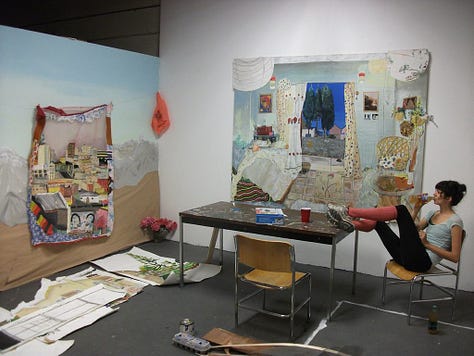
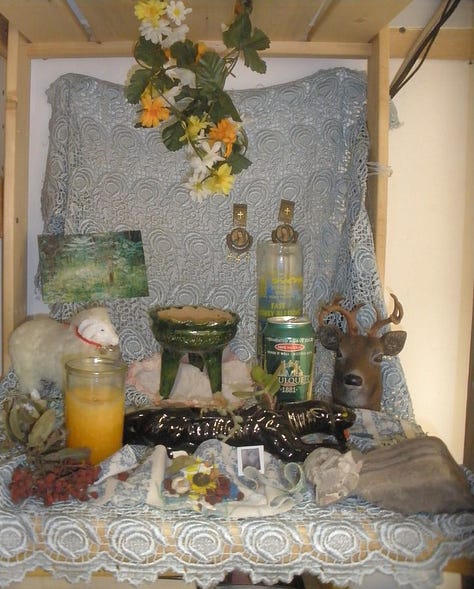
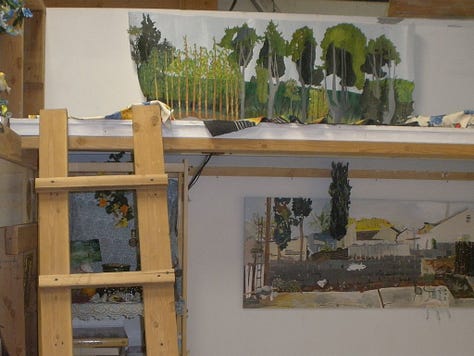
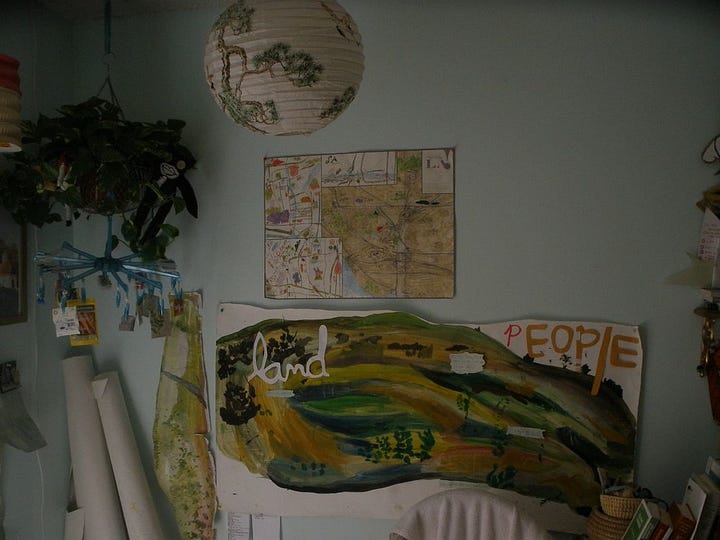
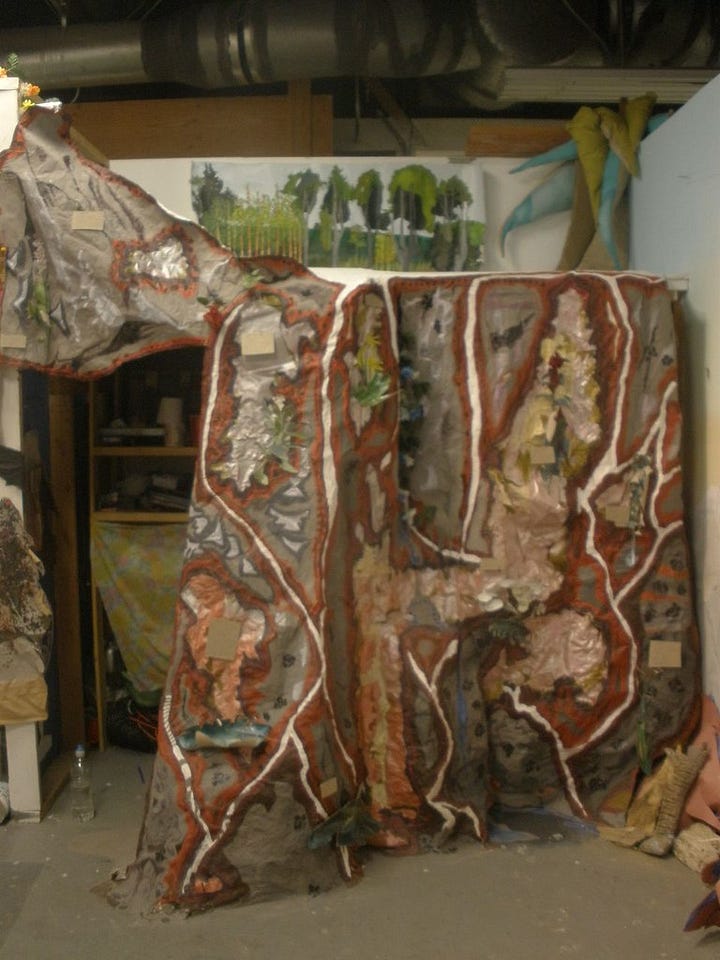
Sarita with collaged paintings of bricolage, multiethnic place, an altar detail inside the studio holding spiritual center amidst psychological attacks, a built-in bed turned tapestry-world to understand my place, research at home, Flower Mountain from scrap papier-mache over the loft to invite the Mexica ancestral realms of Atzlán into the work, 2010
Where were my artist peers for planetary liberation? Where were the references outside of Western Art History? Lari Pittman, my beloved queer Columbian-American painting mentor, convinced me to stay in the program school in spite of the dissonance and patronizing microaggressions from male faculty. Professor Barbara Drucker felt my frustration and pointed me to the Anabolic Studio, or FarmLab.
I reached out to the volunteer coordinator at the urban ecology studio of Lauren Bon, and was greeted with the warmest soul who has become a soul sibling in this wold: mer! Through mer I met the feral urban ecologist icon Nance Klehm (I’d read her article “WeedEater” in Arthur mag for years, marveling at how one could make mead from weeds among other paradigm-shifting practices she shared). mer also introduced me to Olivia Chumacero, who taught Everything is Medicine out of the garden there. Through plants and plant people, I thrived.
Sarita visiting the redwoods, 2010
The reminder of art worlds that coexist in spite of Art World hegemony fueled my desire to track change through human ecological relations and channel Pachamama through paint. David Whitaker was a ceramicist beloved in the year after me at UCLA, and we soon started teaching place-based curricula at nature spots around the city. Art and Nature attracted Katie Bachler (bestie kindred sparkle-heart who also co-founded a Women’s Dinner that became the Women’s Center for Creative Work, now Feminist Center for Creative Work), as well as Gerardo Monterrubio (cermics faculty now at Glendale Community College), Karla Aguíñiga (now Art Gallery Manager & Public Art Advisory Group Chair at Long Beach City college), among many others.
We would meet in the parks around the river, or hills, or flats, and let nature guide us into curriculum-mapping. We would each offer what the land asked us to share; collaborations with soil and plants, people and youth.
Youth at the Art and Nature Summer Camp’s pocket for the Inner Garden, Elysian Park, July 17th, 2012
I found more radical meaning and movement at UCLA’s department of education and in the World Arts and Cultures Department. There I was thrilled to take two classes with Guillermo Gómez-Peña. In one he invited us to script a speech where we could weave fictitious realities into our position and audience. Mine was a speech from the PDTY, or Postnational Department of Transcultural Youth:
The Ministry of Culture will enact the following policy changes immediately. The radical changes reflect a new diplomatic partnership with La Pachamama, o Madre Tierra, or Mother Earth. To end 600 years of anthro-colonialism, the human tribe will no longer adhere to agricultural standards and people affairs- it’s collaboration towards reciprocity: ¡Por Fin!
Liberating her means the following: we will offer personal and family land grants to convert front lawns to food forests. Half of all golf courses will be converted into native and edible/medicinal teaching centers with seed archives, rainwater harvesting workshops, greywater designs, DIY compost systems, and other skill-shares.
Abandoned or unused space for more than one year will be given to diversity, environmental justice, social justice and/or community arts collectives. A proposal for use must include an educational component. Furthermore, any organization or institution that uses public funding is required to go through dismantling racism workshops that tell multiple histories, share a plurality of world views, and unpack white, male, upper-class and/or heterosexual privileges.
All renters will be legally encouraged to grow on the land they rent. Capitalist outreach will include new social history murals besides white historical ones to tell stories on how the West was Really Won. There will be new training in systems of barter and gift exchange. Seeding Earth intelligence will be the goal of critical pedagogical outreach in every town, city, and county.
April 4th, 2011
I expanded this speech into a preamble for what would later become my DIY PhD Dissertation, Textbook for the Ecocene. All my theoretical underpinnings and the living practices that informed them were there. What I viewed in this document at the time as too untethered, too academically unsound, too disparate; I see now as necessarily expansive, experimental, and experiential. How grateful I am to the decolonial books, Earthworkers, and Indigenous lineages of knowledge that guided me with compassion and protocol.
While avoiding the Western art history requirements my degree asked of me, I leaned into the language of plants. I remember thinking: There are sooo many herbs and weeds and native flora to learn?! And the intimidation was real. But, at age 27, I slowly started learning them one-by-one, interest-by-interest, like Olivia encouraged us to do. Start with one plant at a time, she would remind us. Now, at 42, I still barely feel like I am scratching the surface. It’s the humbling beauty of life-long inspiration and plants as muses.
The playful prompts of Guillermo invited me to imagine a world beyond nation-states. Paradigm shifts felt inevitable with the sheer number of multi-ethnic young people being born and fed-up with this empire’s extractive systems of fossil-fueld death. I am not above it, but of it. And outside it. And unlearning it in community. I use gas in my car, I take flights, and I abandoned my zero-waste journey during COVID’s first appearance on the scene.
To lose our living planet is thinking it has to be this way. To succumb to the Anthropocene is to give into nihilism. To allow the white male billionaire minority to continue keeping us and our planet hostage is, in fact, an intellectual and spiritual hegemony of powerlessness. So, we keep cultivating the connected and power-full and fantastical within the spheres of action we can take. Apathy is a killer. Empathy brings coalitions in. Branch, break, bend, bloom. More of the preamble below.
Emblem for the Postnational Department of Transcultural Youth, 2013
Substrate for a Living Pedagogy: the Political Underpinnings of the Postnational Department of Transcultural Youth
“So we went to school to copy, to imitate, not to exchange languages & ideas, & not to develop the best traits that had come out of uncountable experiences of hundreds & thousands of years living upon this continent. Our annals, all happenings of human import, were stored in our song and dance rituals, our history differing in that it was not stored in books, but in the living memory. So, while the white people had much to teach us, we had much to teach them, & what a school could have been established upon that idea!” -Luther Standing Bear, Lakota Sioux
“Colonialism began with the sword & the bullet in Africa, in the Pacific islands, in the Americas, followed by the chalk and the blackboard. Physical violence of the battlefield, psychological violence in the classroom.”
-Ngugi wa Thiong’o, Decolonizing the Mind
What is colonialism at its roots, and colonialism today?
From Marina Griznic’s conversation with Walter Mignolo:
The 16th century colonial matrix of power included the control of authority, control of gender & sexuality, control of economy, and control of knowledge & subjectivity by male, Christian, European and wealthy citizens. Modern Coloniality in the 20th century grew to include a rhetoric of salvation via missionaries, development & modernization, and consumerism & market democracy. Today’s Neoliberalism is the latest form of Imperialism. Linear growth & accumulation takes precedence over humans & life in general.
“Accumulation of money went hand-in-hand with the accumulation of meaning (Universities, banks, etc) Now: polycentric accumulation of money but control of meaning is still in the hands of Western institutions. Knowledge and classification are case as uni-versal, but created and enacted in one region by particular bodies (Western Christian males). They believe in a universal, non-located, disembodied truth. Geo & body-politics of knowledge affirm the right and legitimacy of knowledge disqualified by the imperiality of Euro-centered epistemology as myth, folklore, native, traditional, non-sustainable, demonic, subversive, irrational, etc.” - Marina Griznic
Decoration of everyday objects with adornments reflecting and honoring one’s immediate environment became relegated to craft, and thousands of years of artwork reduced to “World Art,” studied secondarily to “Fine” or “Western” Art.
Capitalism’s final frontier is consumerism and social media preoccupation so that multinational corporations infinitely increase control over the public’s time, spending, and desires. They preach our our right to immediately have anything new that we want; one click away. Creators are imbued with a righteousness to use resources for their art, unapologetic for its planetary impact.
“...The rhetoric works by distancing all objects in culture from the material history of what has made them what they are, an estrangement that deprives {Western} consciousness of any responsibility for what has & will become.”
-Rolande Barthes
Signs of the estrangement include buying things to feel better and the prescriptions of corporate medicine to manage mood and energy.
Spending time every other day in nature (hiking or even just sitting outside in a park) and putting your hands in soil (it holds anti-depressants) rekindles medicine and connection to earth, relieving us from anxiety and loneliness.
“If America had done to us as it wishes to do to her, then the future will not be bright. America is running up a great debt. It may someday see the wholesale despoilation of its lands & people by a foreign nation.” -Vine Deloria
Time isn’t linearly progressing; it is cyclical. The capitalist-colonialist era has peaked, and so we begin another era of respect for the Earth.
“We are nature. We cannot separate ourselves from nature. Our ancestors- everyone’s ancestors- were tribal people who practiced reciprocity with nature. Human beings are tribal beings.”
-Olivia Chumacero, Everything is Medicine (e.i.m.)
“Tribal religions are fine-tuned to harmonize with lands on which people live. Meaninglessness & alienation in our generation is because of preference of time over space. Spatial thinking requires linkage to real places & people. Space must precede time as consideration for thought.”
-Vine Deloria
Artists are bees and messengers: cross-cultural pollinators and surveyors for the postnational and transcultural future con la tierra. In our postnational world there is no space for one hegemonic mode.
“Abuse of material power is a result of spiritual imbalance; the media sells you a constructed mainstream culture.” - Ana Castillo, Massacre of the Dreamers
In our postnational world we reconnect and create cultures that are place-based, people-based, and ancestrally-based.
“US intellectual & academic mindset that Western thought is superior to all else is commingled with equal conviction that indigenous people in the US are intellectually naïve.”
How can we excavate meaning and world-views to heal the the imbalance? Go towards that which has been most suppressed, most silenced as enemy of the existing hegemonies!
“Learning about indigenísmo is a way of learning about ourselves, our acceptance of oneself as an individual & her people, then we can educate the world about ourselves.”
“Women have been relegated to preserving cults created by men, not as official reps, but in rituals of popular culture, passing from generation to generation. As we solicit spiritual guidance no longer from paternal white god [professor, artist] but from brown or black spiritual mother- we return to vital energies taken from her.”
- Ana Castillo
If you want to change the world, you have to start with that with which you have agency: yourself, your home (even if it’s just the tiny spot you lay your head), and your community. Make an offering (a song, etc) and ask the Universe to bring you a teacher, bring you the elders that can show you the ways you’ve been longing to learn. Everything you need you already have.
A Living Pedagogy is a relationship-based approach to teaching and learning with the earth. Humans’ innate creativity (being bodies that are extensions of the Mother of Creation, Mother Earth) can (re)make and transform our immediate environment (the room, the home, their building, outdoor space, street & neighborhood) as we learn about ancient ways of reciprocating with the earth, new radical urban ecology, social movements and the indigenous, ecological, and social histories where we live.
We take back art and aesthetics as pathways towards connection rather than market, disparities in wealth, and accumulation. We make our world to liberate our world. Our dwelling is a personal and cosmological model; becoming seasonal, harmonious, and a site of agency. The home is an anticapitalist space to dissipate alienation and open regenerative processes for the community to witness, as well. We desire to gather around meaning-making. We desire to learn from each others’ experiences. We desire to feel grounded, inspired, and connected to each other.
Aesthetics of the home involve reciprocity with nature and the art of bricolage. Habitats are tended to with intuitive personal aesthetics and the patterns ancestors tucked into textiles and tools as reminders of the beings we show gratitude to. The home is a microcosm of plurinationality, of border-art, of female knowledge and practices of love and spirit. Directly outside of the home looking in is the potential for a renewed relationship with nature (since we are nature--we eat, we breathe, we drink water!) There is a de-alienation through el acto de convivir, and stories of truth and social history behind the plants allowed to grow or anarchically pushing through the anthropocentric city-structures. And these experiences must be shared, allowing for imperfections, and seasonally renewed.
We make-do with aesthetics as the highest form of creativity in Life. Whereas making-do in capitalism is demeaning, making-do as an offering to our home planet revalues identities not based on consumerism. We mirror this to each other. We reconnect without fear of perfectionism, understanding this to be a cyclical process, iterative and emergent, to borrow the empowering and forgiving terms from adrienne maree brown.
tu eres tu casa, tu casa eres tu.
“Everything flows toward soil” -Nance Klehm
Where does the water go after you use it?
Offer your organic waste to the Earth once again
(food scraps, humanure).
La Madre Tierra can’t keep freely giving.
Make a reciprocal home, regrow your tribe.
Be guided by the deep aesthetics of memory and life that dazzle you and remind you how you want to live as an offering.
Be gentle with yourself as you recreate the connections not taught in school, the connections systematically erased by Eurocentric religions and other learning institutions. Reclaim the parts of your blood memory that lived in constant interaction with habitat and community, and weave it into the present. Ask the Universe for help in all of this. Begin with an offering.


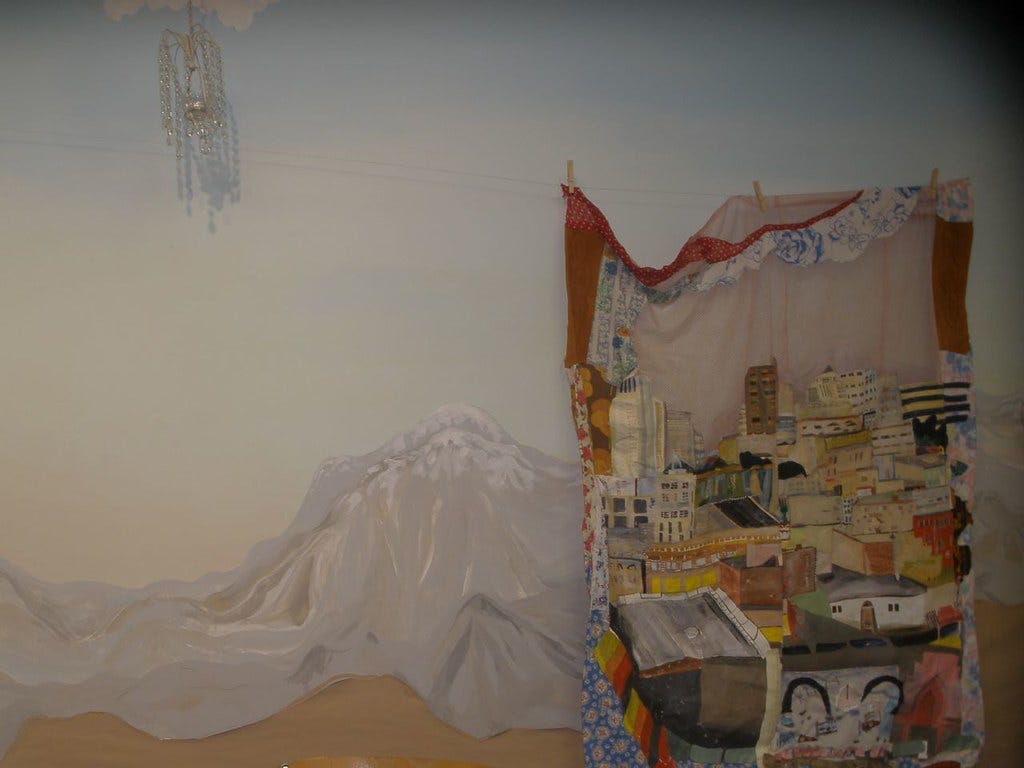
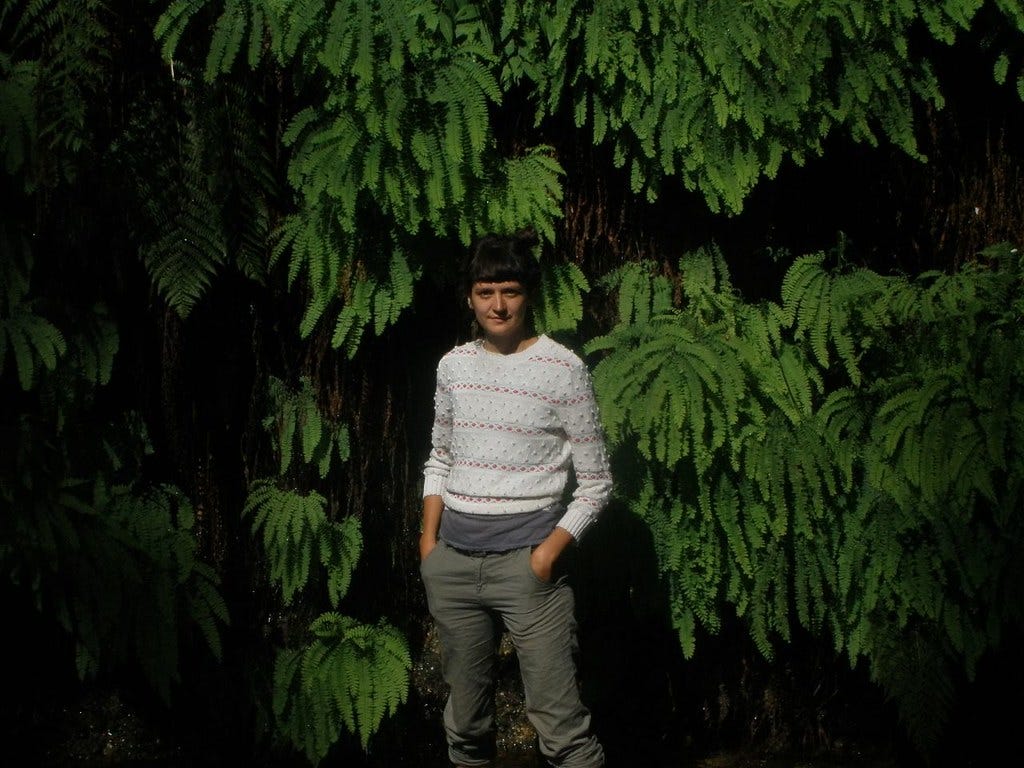
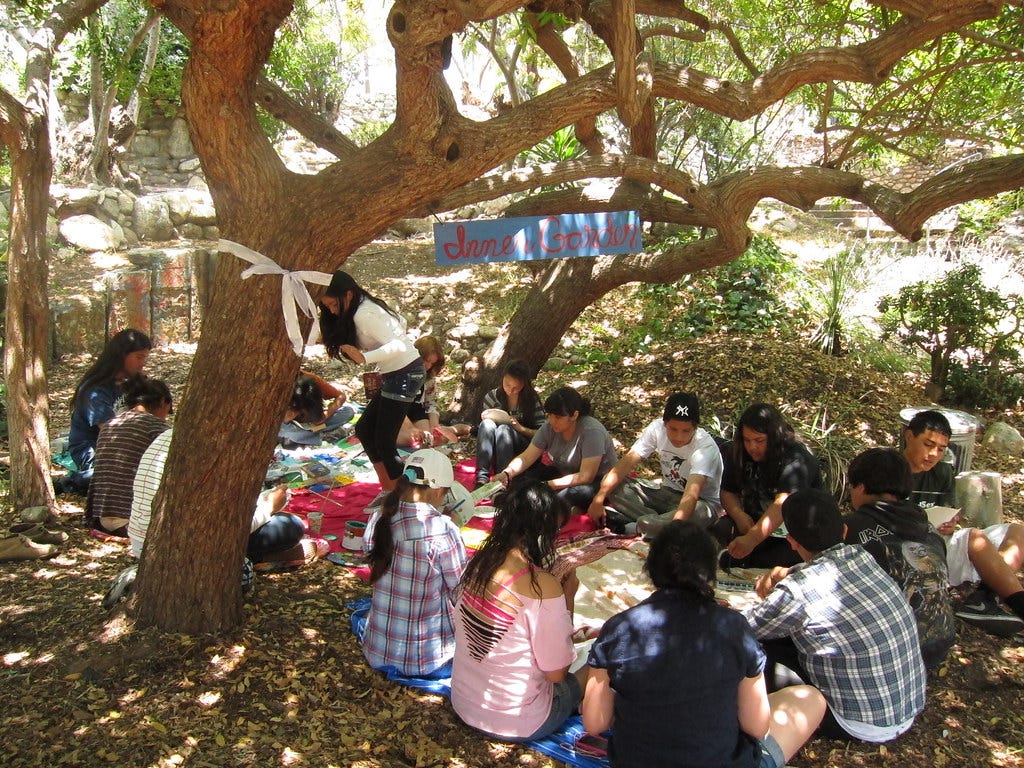

LOVE how mapping your journey to this moment illuminates the depth of your persistence to excavate and unlearn our toxic world while offering a manifesto with tools to invent our way through to planetary liberation of all beings 💩🔥💦🌱💗✨